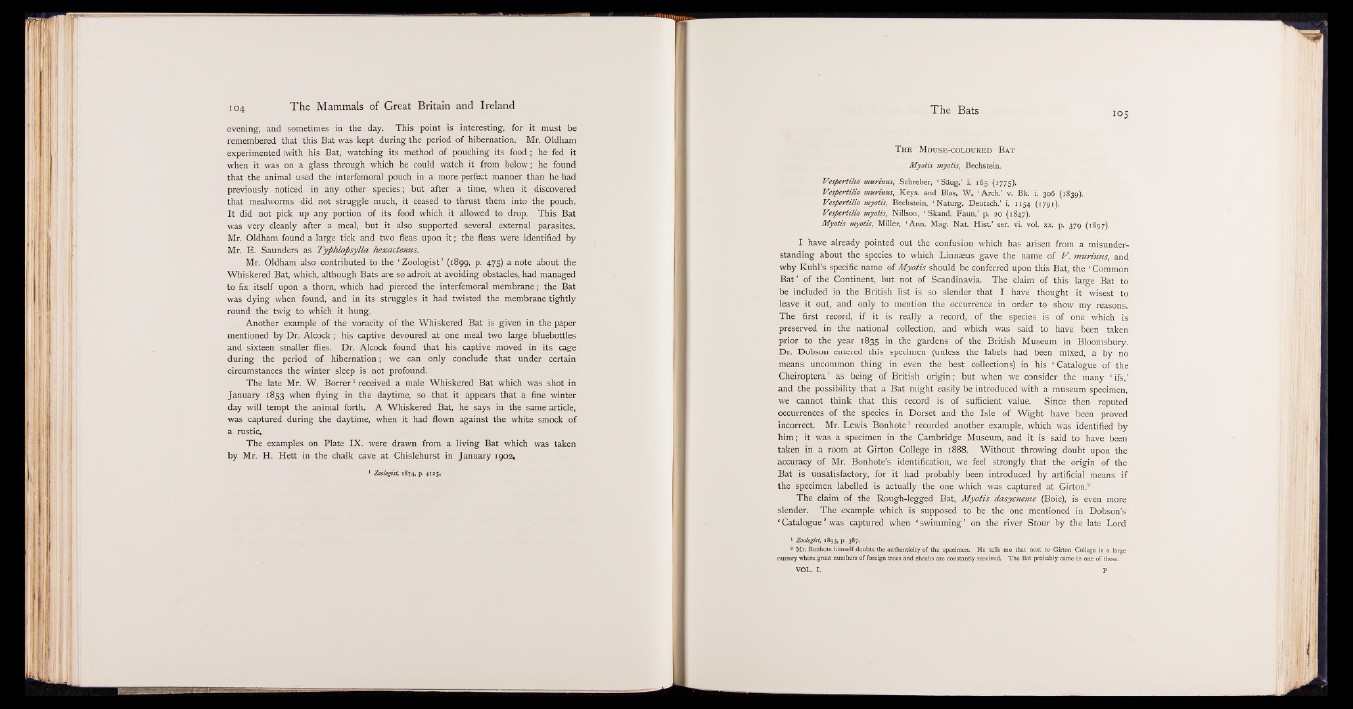
evening, and sometimes in the day. This point is interesting, for it must be
remembered that this Bat was kept during the period of hibernation. Mr. Oldham
experimented 'with his Bat, watching its method of pouching its food; he fed it
when it was on a glass through which he could watch it from below; he found
that the animal used the interfemoral pouch in a more perfect manner than he had
previously noticed in any other species; but after a time, when it discovered
that mealworms did not struggle much, it ceased to thrust them into the pouch.
It did not pick up any portion of its food which it allowed to drop. This Bat
was very cleanly after a meal, but it also supported several external parasites.
Mr. Oldham found a large tick and two fleas upon i t ; the fleas were identified by
Mr. E. Saunders as Typhlopsylla hexactenus.
Mr. Oldham also contributed to the ‘ Zoologist ’ (1899, p. 475) a note about the
Whiskered Bat, which, although Bats are so adroit at avoiding obstacles, had managed
to fix itself upon a thorn, which had pierced the interfemoral membrane; the Bat
was dying when found, and in its struggles it had twisted the membrane tightly
round the twig to which it hung.
Another example of the voracity of the Whiskered Bat is given in the paper
mentioned by Dr. Alcock; his captive devoured, at one meal two large bluebottles
and sixteen smaller flies. Dr. Alcock found that his captive moved in its cage
during the period of hibernation; we can only conclude that under certain
circumstances the winter sleep is not profound.
The late Mr. W. Borrer1 received a male Whiskered Bat which was shot in
January 1853 when flying in the daytime, so that it appears that a fine winter
day will tempt the animal forth. A Whiskered Bat, he says in the same article,
was captured during the daytime, when it had flown against the white smock of
a rustic.
The examples on Plate IX. were drawn from a living Bat which was taken
by Mr. H. Hett in the chalk cave at Chislehurst in January 1902«
Zoologist, 1874, p. 4125,
T h e M o u s e -c o l o u r e d B a t
Myotis myotis, Bechstein.
Vespertihö murinus, Schreber, ‘ Säug.’ i. 165 (1775).
Vespertilio murinus, Keys, and Blas. W* ‘ Arch.’ v. Bk. i. 306 (1839).
Vespertilio myotis, Bechstein, ‘ Naturg. Deutsch.’ 1154 (1791).
Vespertilio myotis, Nillson, ‘ Skand. Faun.’ p. 20 (1847).
Myotis myotis, Miller, ‘ Ann. Mag. Nat. Hist.’ ser. vi. vol. xx. p. 379 (1897).
I have already pointed out the confusion which has arisen from a misunderstanding
about the species to which Linnaeus gave the name of V. murinus, and
why Kuhl’s specific name of Myotis should be conferred upon this Bat, the ‘ Common
Bat ’ of the Continent, but not of Scandinavia. The claim of this large Bat to
be included in the British list is so slender that I have thought it wisest to
leave it out, and only to mention the occurrence in order to show my reasons.
The first record, if it is really a record, „of the species is of one which is
preserved in the national collection, and which was said to have been taken
prior to the year 1835 in the gardens of the British Museum in Bloomsbury.
Dr. Dobson entered this specimen (unless the labels had been mixed, a by no
means uncommon thing in even the best collections) in his 1 Catalogue of the
Cheiroptera ’ as being of British origin; but when we consider the many * ifs,’
and the possibility that a Bat might easily be introduced with a museum specimen,
we cannot think that this record is of sufficient value. Since then reputed
occurrences of the species in Dorset and the Isle of Wight have been proved
incorrect. Mr. Lewis Bonhote1 recorded another example, which was identified by
him; it was a specimen in the Cambridge Museum, and it is said to have been
taken in a room at Girton College in 1888. Without throwing doubt upon the
accuracy of Mr. Bonhote’s identification, we feel strongly that the origin of the
Bat is unsatisfactory, for it had probably been introduced by artificial means if
the specimen labelled is actually the one which was captured at Girton.2
The claim of the Rough-legged Bat, Myotis dasycneme (Boie), is even more
slender. The example which is supposed to be the one mentioned in Dobson’s
* Catalogue ’ was captured when ‘ swimming ’ on the river Stour by the late Lord
1 Zoologist, 1893, p. 387.
2 Mr. Bonhote himself doubts the authenticity of the specimen. He tells me that next to Girton College is a large
nursery where great numbers of foreign trees and shrubs are constantly received. The Bat probably came in one of these.
VOL. I.